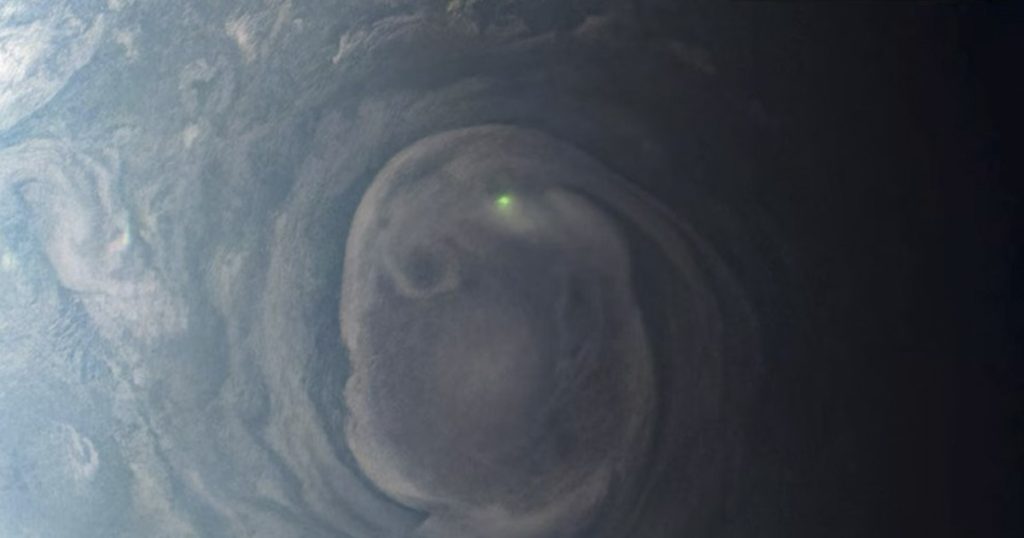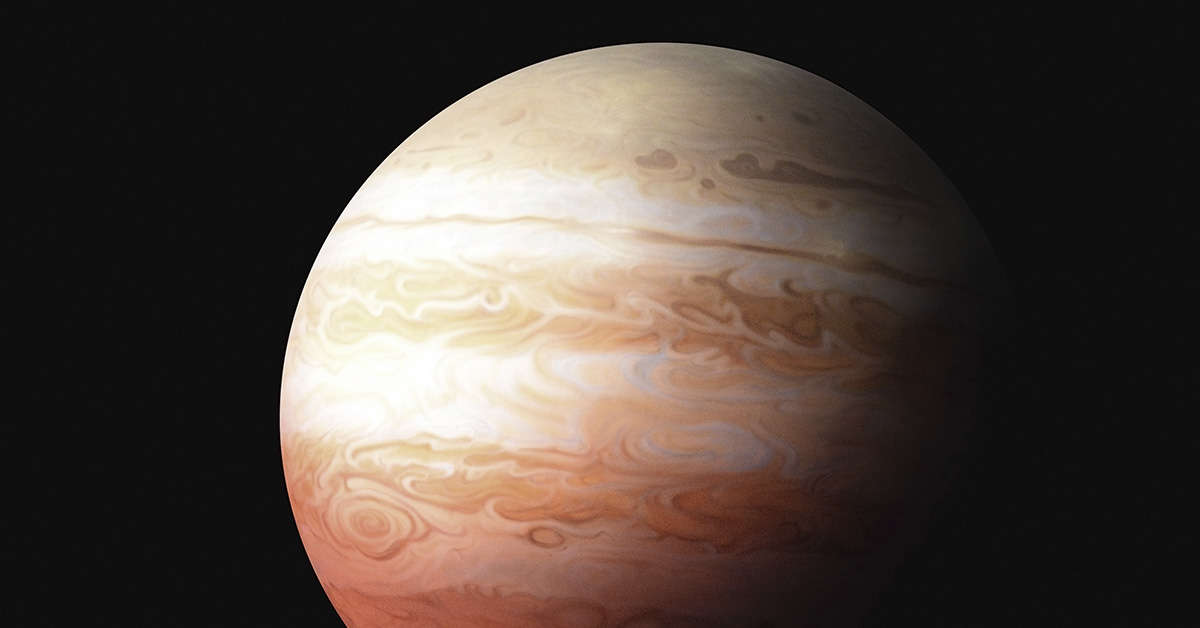Jupiter, the largest planet in our solar system, is renowned for its colossal storms. Recently, scientists captured a remarkable image showing a green light emanating from an area near the planet’s North Pole. This mesmerizing phenomenon is believed to be a lightning strike occurring within the planet’s swirling vortex.1
On Earth, lightning typically originates from water clouds. However, Jupiter’s lightning strikes emerge from clouds consisting of a combination of ammonia and water. This stark contrast in cloud composition highlights the unique atmospheric conditions on the gas giant.

Another intriguing distinction is the planet’s distribution of lightning. While most lightning bolts on Earth occur near the equator, Jupiter experiences a higher frequency of lightning near its poles. This discrepancy adds to its distinctiveness in weather patterns compared to our home planet.
The discovery of lightning within Jupiter’s atmosphere provides valuable insights into the complex dynamics and electrical activity occurring on the giant planet. By studying these phenomena, scientists can enhance their understanding of the planet’s atmospheric processes, further unraveling the mysteries that make this celestial body so captivating.
A Bit More About Jupiter
While Jupiter shares its origins with the Sun, its heavy element composition remains a mystery. The Galileo probe, one of seven spacecraft sent to the planet, found a different abundance of heavy elements in Jupiter compared to the Sun.2,3 One theory suggests that these heavy elements come from comets, asteroids, and other celestial bodies it has consumed. Another theory proposes that Jupiter formed farther away from the Sun than its current orbit. However, further study is needed to understand the true source of these elements.
Water plays a crucial role in Jupiter’s formation. Scientists believe that water ice hitchhiked on early comets and asteroids, bringing heavier elements to Jupiter beyond the original hydrogen and helium present in the solar system. Surprising findings indicate that water persists in Jupiter’s atmosphere, even after comet impacts.
Jupiter’s interior is another enigma. Its core and the extent of the liquid hydrogen layer remain uncertain. Juno, a spacecraft orbiting the planet, aims to study its atmosphere, gravity, and magnetic field to shed light on its mysterious interior. Recent findings suggest that Jupiter’s core may be larger than expected, challenging previous assumptions about its structure.
Dynamic Atmosphere
Jupiter’s atmosphere is a beautiful mess of clouds, storms, and colorful bands. Understanding its weather patterns and atmospheric phenomena poses a significant challenge for scientists.
The distinctive cloud bands are composed of cold, windy clouds of ammonia and water, floating in an atmosphere primarily made up of hydrogen and helium. The Great Red Spot, a giant storm larger than Earth, has captivated astronomers for centuries. However, the reasons for its shrinkage remain unknown. Studying Jupiter’s weather patterns can provide insights into atmospheric dynamics and storm formation.
The planet’s belts and zones, characterized by the alternating bands of clouds, display remarkable jet streams and changing rotations. These phenomena, driven by the planet’s fast rotation, are still not fully understood. Recent data from the Juno spacecraft suggests that ammonia plays a role in the alignment of jet streams. Additionally, the transition of belts and zones beneath the water clouds reveals intriguing similarities to our oceans, providing clues about atmospheric behavior.
Jupiter’s Moons and Potential for Life
Jupiter’s four largest moons – Io, Europa, Ganymede, and Callisto – known as the Galilean moons, are fascinating in their own right. From Io’s volcanic activity to Ganymede’s status as the largest moon in the solar system, each moon offers unique opportunities for exploration and discovery. These moons’ interactions with Jupiter, such as tidal effects and orbital resonances, add complexity to the Jovian system.
While Jupiter itself may not be suitable for life, its moons offer intriguing possibilities. Let’s explore the potential for life and the fascinating characteristics of Jupiter’s moons. Europa, one of the largest moons, holds immense scientific interest. Evidence suggests the presence of a vast ocean beneath its icy crust, making it a promising candidate for extraterrestrial life.4 Future missions like NASA’s Europa Clipper aim to study Europa’s hidden oceans, magnetic field, surface activity, and potential habitability.
Conclusion
Jupiter, the mighty giant of our solar system, continues to astound us with its mysteries. From its enigmatic composition to its dynamic atmosphere and potential for life on its moons, Jupiter offers a wealth of scientific questions yet to be answered. Continued exploration and upcoming missions like Europa Clipper will undoubtedly bring us closer to better understanding the secrets of this planet and its complex system of moons. As we uncover more about this planet, we gain valuable insights into the formation, evolution, and diversity of planetary systems both within and beyond our solar system.
Keep Reading: Astronaut shares the profound ‘big lie’ he realized after seeing the Earth from space
Sources
- “NASA spacecraft spots eerie green light on Jupiter.” WMBF News. June 20, 2023.
- “Jupiter’s 10 most massive mysteries.” Space. Elizabeth Howell. December 29, 2022
- “Ten Interesting Facts About Jupiter. Universe Today. Matt Williams. April 3, 2016.
- “Jupiter.” Solar System.

